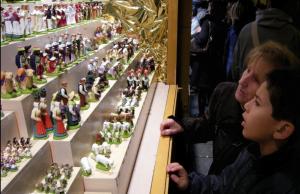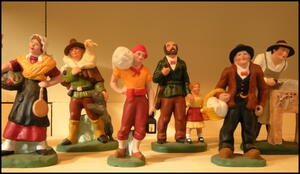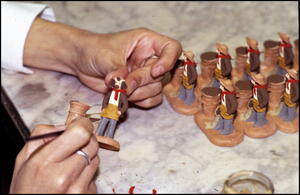In the country of the "Little Saints"
Two centuries ago, in 1794, an edict of the Convention, one of the political bodies born out of the French Revolution, expressly forbade public expressions of faith. Churches were closed and participating in a live Nativity scene, a Christmas tradition dating back to the early Middle Ages, became liable for punishment.
For several centuries, in churches and on the stage, simple folk had dressed as Joseph, Mary, the Angel, the Three Kings, and re-enacted the birth of the infant Jesus warmed by the breath of the ox and donkey in the Bethlehem manger. Now people had no choice but to respect the tradition in hiding, in the privacy of their homes.
Of course, there was much less room in a house than in a church and the live Nativity scenes, especially in Provence, were progressively abandoned and replaced with miniature "cribs" and "crèches" with wood or clay characters. This was how the "santon" came to be. These are the "little saints" that play such an important role in this region's Christmas traditions.
But then in the mid-19th century, a far-reaching movement developed in Provence, both political and literary, aimed at reviving the local language and culture. One of its leaders, Frédéric Mistral (who was to win the Nobel Prize for Literature in 1904), considered provençal as "the first literary language of civilized Europe."
Christmas traditions were a big part of this revival. Soon, new clay characters, typical of rural life in Provence, appeared in the crèche: the baker and the well digger, the knife grinder, the country priest, the Gypsy, the "Ravi"—a village idiot—and an Announcing Angel bearing the provençal name "Boufareù," meaning "the one who blows" (the trumpet).
These characters have become an integral part of the Nativity scene that every family, whether religious or not, places at the foot of the Christmas tree. One can meet them all, in various sizes and styles, at the santon fairs that are organized throughout Provence in the last weeks of December. Marseille's "Foire aux Santons"—the largest and most famous of all—has been held every single Christmas season since 1803.




